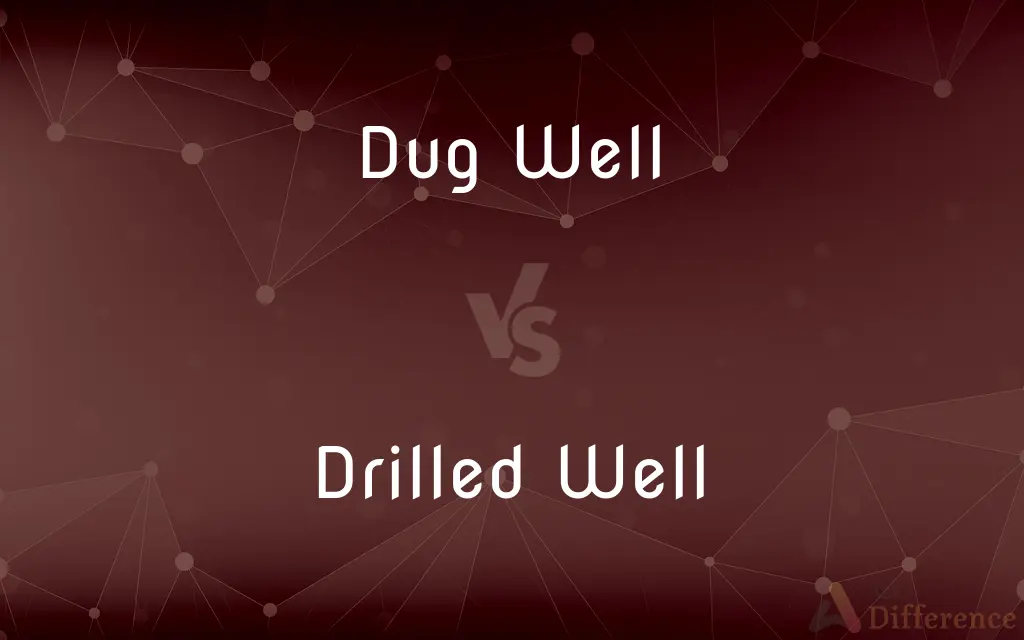Dug Well vs. Drilled Well — What's the Difference?
Edited by Tayyaba Rehman — By Urooj Arif — Published on July 11, 2024
A dug well is manually excavated, typically shallow and prone to contamination, while a drilled well, created with drilling equipment, can reach deep aquifers, offering cleaner water.

Difference Between Dug Well and Drilled Well
Table of Contents
ADVERTISEMENT
Key Differences
Dug wells are traditional, manually excavated pits, often not deeper than 30 feet. They access groundwater near the surface, making them easier to construct but more susceptible to surface contamination. Drilled wells, on the other hand, use mechanical drilling rigs to penetrate much deeper into the earth, sometimes thousands of feet, tapping into deeper groundwater sources that are less likely to be contaminated.
The construction time for a dug well is generally shorter since it involves simpler techniques and tools. This also means they can be more cost-effective in the short term. Drilled wells require specialized machinery and expertise, leading to higher initial costs and longer construction times, but they are more durable and have a longer lifespan.
Water quantity is another differentiator. Dug wells have a limited supply, directly influenced by surface water levels and immediate groundwater. Drilled wells can access more stable water sources deep underground, offering a more reliable water supply, especially during dry periods.
In terms of maintenance, dug wells are more open to elements and require regular cleaning and monitoring to ensure water quality. Drilled wells, with their sealed construction, have lower maintenance needs and are better protected against contaminants.
The risk of contamination is significantly higher in dug wells due to their shallow depth and open nature, making them vulnerable to runoff, pesticides, and bacteria. Drilled wells, with their depth and casing, provide a natural barrier against surface contaminants, making the water safer for consumption.
ADVERTISEMENT
Comparison Chart
Depth
Up to 30 feet
100 to 1000+ feet
Construction
Manual excavation
Mechanical drilling
Cost
Lower initial cost
Higher initial cost
Water Quality
More prone to contamination
Less prone to contamination
Lifespan
Shorter (decades)
Longer (50 years+)
Compare with Definitions
Dug Well
Susceptible to surface contamination.
After heavy rains, the dug well's water needed testing.
Drilled Well
Created using drilling equipment to reach deep aquifers.
The new drilled well supplies the entire village.
Dug Well
A manually excavated hole accessing shallow groundwater.
The farm's dug well provides water for irrigation.
Drilled Well
Involves higher initial costs and complexity.
Installing the drilled well required a professional team.
Dug Well
Relies on groundwater near the surface.
The dug well runs dry during prolonged droughts.
Drilled Well
Encased to prevent contamination.
The drilled well's casing was inspected for integrity.
Dug Well
Simple construction and maintenance.
They cleaned the dug well with basic tools.
Drilled Well
Offers cleaner, more reliable water.
Their drilled well provides consistent water quality year-round.
Dug Well
Often lined with stones or bricks for stability.
The old dug well was lined with fieldstones.
Drilled Well
Can reach depths of over a thousand feet.
The drilled well taps into an aquifer 800 feet deep.
Common Curiosities
Can a dug well run dry?
Yes, dug wells can run dry if the groundwater level drops below the well's depth, especially during droughts.
Which type of well is more prone to contamination?
Dug wells are more prone to contamination due to their shallow depth and susceptibility to surface runoff.
What maintenance does a dug well require?
Dug wells require regular cleaning and water quality testing to manage contamination risks.
What is the main difference between a dug and drilled well?
Dug wells are manually excavated shallow pits, while drilled wells are created with machinery to access deeper groundwater sources.
Is the water quality from a drilled well generally better?
Yes, drilled wells access deeper aquifers less affected by surface contamination, offering better water quality.
Are drilled wells more expensive than dug wells?
Yes, drilled wells typically have higher initial costs due to the machinery and expertise required.
What kind of maintenance does a drilled well need?
Drilled wells require periodic inspection, cleaning, and sometimes repair of mechanical components and casing.
How long does a drilled well last?
A drilled well can last 50 years or more with proper maintenance.
Can a drilled well access any type of water source?
Drilled wells can access deep groundwater sources, but not all areas have aquifers suitable for drilling.
Are there any legal considerations for well construction?
Yes, both dug and drilled wells must comply with local regulations regarding location, construction, and water testing.
Why might someone choose a dug well over a drilled well?
Lower initial costs and simpler construction might make dug wells appealing for certain applications or in less affluent areas.
How deep is a typical dug well?
Typically, dug wells are not deeper than 30 feet to remain accessible for manual excavation.
Can the depth of a drilled well affect its water quality?
Generally, deeper wells access cleaner water, as they are less influenced by surface contamination.
What is the environmental impact of drilling a well?
Drilling can impact local ecosystems and aquifers if not managed properly, though regulations aim to minimize these effects.
How does weather affect a dug well?
Weather, especially heavy rains, can introduce contaminants into a dug well or affect its water level.
Share Your Discovery

Previous Comparison
Beef Brisket vs. Corned Beef Brisket
Next Comparison
Cabinet Minister vs. State MinisterAuthor Spotlight
Written by
Urooj ArifUrooj is a skilled content writer at Ask Difference, known for her exceptional ability to simplify complex topics into engaging and informative content. With a passion for research and a flair for clear, concise writing, she consistently delivers articles that resonate with our diverse audience.
Edited by
Tayyaba RehmanTayyaba Rehman is a distinguished writer, currently serving as a primary contributor to askdifference.com. As a researcher in semantics and etymology, Tayyaba's passion for the complexity of languages and their distinctions has found a perfect home on the platform. Tayyaba delves into the intricacies of language, distinguishing between commonly confused words and phrases, thereby providing clarity for readers worldwide.














































